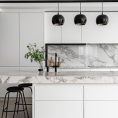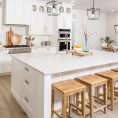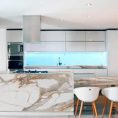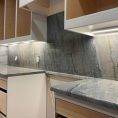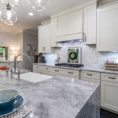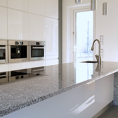How to Design a Functional Kitchen with the Right Countertops
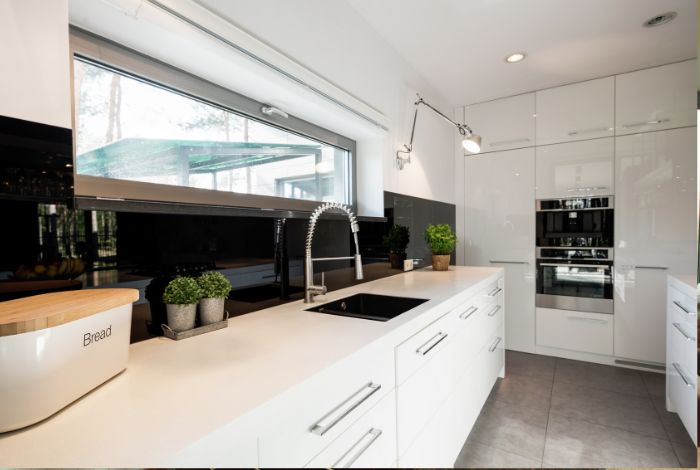
Designing a functional kitchen is essential for creating a space that is not only beautiful but also practical and efficient. One of the key elements in achieving this balance is selecting the right countertops. Countertops are not only a major focal point in your kitchen but also play a crucial role in your kitchen’s usability and durability. In this article, we will explore how to design a functional kitchen by choosing the right countertops, focusing on factors such as material, layout, and maintenance.
Choosing the Right Countertop Material
Selecting the right material for your countertops is the first step in designing a functional kitchen. Different materials offer various benefits and aesthetics, so it’s important to choose one that fits your needs and style.
Granite
- Durability: Granite is incredibly durable and resistant to scratches and heat, making it an excellent choice for busy kitchens.
- Aesthetic: Available in a wide range of colors and patterns, granite can complement any kitchen design.
- Maintenance: Requires periodic sealing to protect against stains and moisture.
Quartz
- Non-Porous Surface: Quartz is non-porous, making it highly resistant to stains and bacteria, perfect for maintaining a hygienic kitchen.
- Variety: Offers a consistent look with a wide range of colors and patterns.
- Maintenance: Low maintenance and does not require sealing.
Quartzite
- Natural Beauty: Combines the beauty of marble with the durability of granite.
- Durability: Highly resistant to heat and scratches.
- Maintenance: Requires sealing to protect against stains and etching.
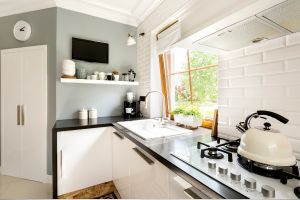
Designing a functional kitchen is essential for creating a space that is not only beautiful but also practical and efficient.
Dolomite
- Balanced Properties: Offers a mix of durability and aesthetic appeal, sitting between marble and granite.
- Appearance: Features subtle veining and neutral tones that complement many kitchen styles.
- Maintenance: Needs regular sealing and careful cleaning.
Porcelain
- Versatility: Porcelain can mimic the look of natural stone, wood, or metal.
- Durability: Extremely hard and resistant to scratches, stains, and heat.
- Maintenance: Easy to clean with regular household cleaners.
Marble
- Luxurious Aesthetic: Known for its timeless beauty and unique veining.
- Cool Surface: Ideal for baking and pastry preparation.
- Maintenance: Requires diligent care and regular sealing to prevent stains and etching.
Designing for Functionality
To design a functional kitchen, consider the layout and how the countertops will be used in different areas of your kitchen.
Kitchen Island
- Multi-Use Space: An island can serve as a prep area, dining space, and storage solution. Choose a durable material like granite or quartz that can handle heavy use.
- Size and Shape: Ensure the island is proportionate to your kitchen size to avoid obstructing movement and workflow.
- Integration: Include features like a sink, cooktop, or seating to maximize functionality.
Prep Zones
- Durable Surfaces: Use materials that can withstand heavy use and are easy to clean, such as quartz or granite.
- Ample Space: Ensure there is enough countertop space for food preparation near the stove and sink.
Cooking Area
- Heat Resistance: Choose heat-resistant materials like granite or quartzite for countertops near the stove and oven.
- Convenient Layout: Ensure that the cooking area is easily accessible and has enough countertop space for placing hot pots and pans.
Sink Area
- Water Resistance: Use non-porous materials like quartz or porcelain around the sink to prevent water damage and staining.
- Integrated Features: Consider integrated sinks or drainboards to enhance functionality and ease of cleaning.
Storage Solutions
- Built-In Storage: Design countertops with built-in storage solutions, such as drawers and cabinets, to keep kitchen essentials within easy reach.
- Open Shelving: Incorporate open shelving above countertops for easy access to frequently used items.
Maintenance Considerations
Maintaining your countertops is crucial for preserving their beauty and functionality over time.
- Regular Cleaning: Clean countertops daily with appropriate cleaners to prevent buildup of dirt and grime.
- Sealing: Materials like granite, quartzite, dolomite, and marble require regular sealing to protect against stains and moisture.
- Preventive Measures: Use cutting boards, trivets, and coasters to prevent scratches, heat damage, and stains.
Aesthetic and Practical Balance
Achieving a balance between aesthetics and practicality is key to designing a functional kitchen.
- Color Coordination: Choose countertop colors and patterns that complement your cabinets, flooring, and overall kitchen design.
- Edge Profiles: Select edge profiles that match your design style while considering safety and ease of cleaning.
- Lighting: Proper lighting can enhance the appearance of your countertops and make food preparation easier.
Designing a functional kitchen with the right countertops involves considering the material, layout, and maintenance needs. By selecting the appropriate countertop material and ensuring that your kitchen design supports efficient workflow and easy maintenance, you can create a space that is both beautiful and practical. Whether you prefer the durability of granite, the low maintenance of quartz, or the luxurious look of marble, there is a perfect countertop material to meet your needs.

